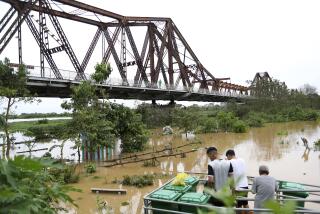The Weather Is Going to Extremes in Wreaking Havoc
- Share via
DONG HA, Vietnam — Every day for the last three months, Truong Thi Hoa has prayed for rain, leaving extra offerings of food and drink before the family shrine. But nothing has worked.
Thick ripples scar the 2.5-acre family plot where the dry earth has shriveled into broken clods.
“We have lost all the rice for this year,” she says wearily. “Even if it rains now, it won’t matter.”
The most severe drought to hit the central region of Vietnam in nearly a century has turned swaths of emerald-green rice paddies into a patchwork of dead, brown fields.
Officials estimate that about 1 million people are going hungry in the country’s six central provinces. More than 2 million are facing serious shortages of drinking water.
The months-long dry spell has hit hardest here in Quang Tri province.
About 22,000 acres of the summer-autumn rice crop have been destroyed, and damage to livestock and rice production is estimated at $14.5 million, says Tran Tuu, the province’s director of agriculture and rural development.
Ninety percent of the reservoirs in the province have dried up. Fires have raged in tinder-dry forests, burning hundreds of acres. Families are hiking as many as four miles a day to buy fresh water at black-market prices.
“It’s been so dry, you can drive a car along the bottom [of the reservoir],” Tuu says.
Agriculture officials have nervously eyed the low rainfall since December.
“Last year after we got so little rain, we realized what could happen, but there was nothing we could do,” Tuu says.
For the small farmers who make up 80% of the 500,000 population in the province, the loss of a season’s worth of crops means virtual disaster for families who are barely able to eke out a living from year to year.
In a normal year, Hoa and her family are able to harvest 2 tons of rice, which they sell for about $230, she says. Most of the money usually goes toward the seed and fertilizer for next year’s crops.
This year, they are scraping by, borrowing food from relatives. But they consider themselves lucky, she says. They haven’t had to sell their two water buffaloes yet.
“What else can we do? Leave here?” she asks. “Where would we go? If you depend on rice crops for your life, then you must accept what nature brings.”
Even in the shade of the one-room mud-brick home Hoa shares with her husband, four children and her parents, it’s sweltering. Temperatures have exceeded 100 degrees weeks at a time.
Compounding the misery are epidemic levels of mosquito-borne dengue and malaria. Ironically, it’s the lack of water that has hastened the spread of the diseases.
People hoarding water have unwittingly provided a breeding ground for mosquitoes in wells and storage tanks. So far this year, 8,779 cases of dengue and 3,253 cases of malaria have been reported, with a handful of fatalities, says Tran Tien Phung, provincial director of preventive medicine.
In his 80 years, village elder Tran Van Loi says, he can’t remember a year as bad as this one. His daughter and granddaughter have both been stricken with dengue, which causes headaches, fever and aching joints. His crops of rice and cassava are dead, withered to their roots.
“We kept hoping it would rain. No one expected it to last so long,” Loi says. “Then came the sickness. It has been like a nightmare.”
Provincial officials have issued a plea for help. The U.S. Embassy in Hanoi recently pledged $235,000 in aid for the three worst-hit provinces: Quang Tri, Quang Binh and Ha Tinh. Meanwhile, Hanoi has offered $142,000 worth of assistance.
But much of the aid is too little, too late. Down the road in Do Mai village, Pham Quang Thanh, 32, has already sold off the household furniture to buy food for his wife and two children.
First it was the table and chairs. Last week, they gave up their bed. In its place, a plastic sheet covers the dirt floor of their thatched-roof home.
“We heard the government will give rice to help drought victims, but we haven’t seen anything yet,” Thanh says.
Thanh will head down the coast in a week, hoping to find work on the coffee farms in the south. He needs the money for November’s seed planting.
Recent days have brought a glimmer of cooler, rain-moistened air. The city of Hue, just to the south, has already received some rain. Autumn is almost here.
“Next year will be better,” Thanh offers stoically. “It can’t be any worse.”
More to Read
Sign up for Essential California
The most important California stories and recommendations in your inbox every morning.
You may occasionally receive promotional content from the Los Angeles Times.











